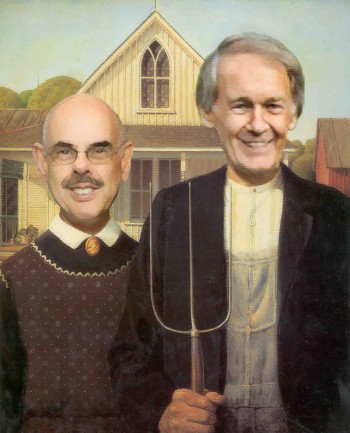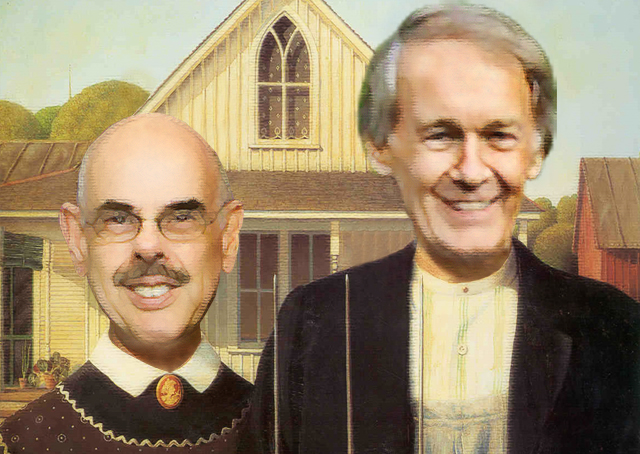 Waxman and Markey prepare for the ag lobby.
Waxman and Markey prepare for the ag lobby.
As the Waxman-Markey climate and energy bill moves forward in the House, Big Ag interest groups are circling their plows and sharpening their pitchforks. Some of the largest corporations in the agribusiness sector–including the GMO-and-herbicide giant Monsanto–are pushing to control how agriculture would fit into the bill’s cap-and-trade scheme.
The main agent for their will is House Agriculture Committee Chairman Collin Peterson (D-Minn.), who has launched a veritable jihad to make sure the historic climate legislation hews to the interests of “production” (i.e., industrial) agriculture. Via Farm Policy blog, here’s an MP3 clip of Peterson’s latest harumphing on Waxman-Markey, in an interview with a radio program called Agritalk, which is sponsored by Monsanto, Syngenta, and Archer Daniels Midland.
Peterson has vowed to line up 35 to 40 Democratic representatives from ag-heavy states to vote against the bill on the House floor if his agenda isn’t accepted–giving him something close to de facto veto power. In the AgriTalk segment, Peterson says, “I don’t think it [Waxman-Markey] has the votes” to prevail on the House floor. Translation: If I don’t get what I want, I’m squashing it.
The current version of Waxman-Markey contains almost no language on agriculture. (As I’ve written before, agriculture is exempt from any cap on greenhouse-gas emissions.) But farming projects would still be eligible for offsets through an offsets-review board that the legislation would set up within the EPA. Big Ag isn’t content with that arrangement. In the coming days, the game will be to insert specific language around ag offsets into the legislation–and promote a certification process developed by Big Ag itself.
And while the Ag Committee has little formal jurisdiction over the final form of Waxman-Markey, Peterson’s influence will be felt. As she did during negotiations around last year’s Farm Bill, House Speaker Nancy Pelosi (D-Calif.) has alighted on the Midwest to assure the ag industry of her fealty. “Agriculture is very important,” Pelosi declared in an Iowa speech on Monday. Pelosi was scheduled to meet with Peterson in Minnesota on Tuesday–an eerie echo of a trip she made during a key point in the 2007-2008 Farm Bill debate, before signing off on a much more agribiz-friendly version of the legislation than reformers hoped for.
[On Thursday, the House Ag Committee will hold hearings on Waxman-Markey, and Grist’s Kate Sheppard will be there to report.]
If the ag giants get their way, they could seriously compromise the legislation’s ability to mitigate climate change. Few deny that changes in agriculture practice could be a major force for sequestering carbon, cutting fossil-fuel use, and stabilizing the climate. A paper by Rattan Lal, director of the School of the Environment and Natural Resources at Ohio State University, estimates that U.S. farmers could capture 288 million tons of carbon in their soil every year–enough to offset about about 17 percent of total U.S. GHG emissions.
Other sources cite an even larger potential role for agricultural practices to mitigate climate change. Pennsylvania-based Rodale Institute reckons [PDF] that “practical organic agriculture, if practiced on the planet’s 3.5 billion tillable acres, could sequester nearly 40 percent of current CO2 emissions.”
To move in that direction would require a tremendous shift in practices, Lal told me in an interview: a move to farming that explicitly seeks to build organic matter in soil. That means reduced tillage, extensive cover cropping, and “as much manure and compost as possible.”
Yet the agenda being pushed by Big Ag is much less about rewarding farmers for shifting practice than it is about rewarding farmers for current practices: in other words, another sop to the large agribusiness firms that dominate our food system.
Big Ag’s politically engineered carbon market
Big Ag’s push to control the carbon-credit market centers on a group called Novecta, which identifies itself as a “consulting company owned by the Iowa and Illinois Corn Growers Associations.” Since December 2007, Novecta has been working to create a standardized process for verifying the value of ag offsets–and has recently come out with a draft proposal [PDF].
Novecta isn’t shy about its affiliations with agribusiness groups. In a recent phone interview, Novecta project director Gary DeLong explained to me that the group has worked with some 70 entities in coming up with its plan. “I can name a few off the top of my head,” he said. “Most of the big companies … Bayer, Monsanto, Syngenta, and Dupont.”
That was a remarkable statement–he had just casually named the quartet of agrichemical giants that literally own the global market for genetically modified seeds.
Monsanto has taken a particular interest in the process. I’ve gotten hold of a one-page Novecta “Congressional Briefing Report” [PDF] describing a trip to Washington May 11-12. The purpose of the trip was to preview the ag carbon-trading draft for key congressional players and USDA officials. The report contains this fascinating tidbit–one that gives insight into the access to power enjoyed by companies like Monsanto:
Mike Parrish form [sic] Monsanto allowed us to meet from 4:00 – 6:00 at the Monsanto office to put the final touches to the presentation for the Congressional briefing. He gave us background and coached us on the presentation. We want to give a big thanks to Mike and his staff for all the time and contacts to set up the briefings. It would not have happen [sic] without their efforts.
Michael Parrish is Monsanto’s vice president for government affairs–that is, its chief lobbyist. Monsanto has also engaged in direct lobbying around Waxman-Markey, its first-quarter 2009 Lobbying Report [PDF] reveals. The GMO giant spent $2 million on a variety of lobbying activities, including efforts to influence the renewable fuel standard and Waxman-Markey.
In our phone interview, Novecta’s Delong mentioned those Monsanto-arranged meetings in Washington. “We gave a briefing to both sides of Congress on May 12th,” he told me, adding that they also presented to two USDA divisions. “They seemed very appreciative of our efforts.”
Payments for ‘chemical no-till’?
Why would Monsanto and other agrichem firms be so interested in controlling how ag is treated by cap-and-trade? By generating payments to farmers who use their goods, these companies burnish their bottom lines and turn climate-change legislation into an indirect revenue stream.
A case in point is a farming practice called “no-till.” In no-till systems, farmers plant directly into fields without plowing. One of the main reasons farmers plow is to control weeds. In a practice that has become known among critics as “chemical no-till,” farmers idle the the plow and rely on chemical herbicides for weed control. Monsanto’s “Roundup Ready” seeds–genetically modified to withstand lashings of Monsanto’s herbicide glyphosate–have greatly facilitated chemical no-till in the Midwest: farmers can spray their fields with Roundup as needed, without affecting the crops. According to the Center for Food Safety [PDF], glyphosate use jumped 15-fold between between 1994 (when GMOs were first released) and 2005, generating a windfall in Roundup sales for Monsanto. Monsanto now clears more than $1 billion per year in profits from Roundup alone.
The Novecta carbon-trading scheme would reward farmers with carbon credits for this practice. In my conversation with Novecta’s Delong, he listed conventional no-till as one of three main areas for ag offsets (the others were “managed grassland” and “managed rangeland”).
As a source of carbon sequestration, chemical no-till is a highly questionable practice. In a 2006 peer-reviewed paper [PDF] called “Tillage and soil carbon sequestration–what do we really know?,” a group of soil scientists led by John M. Baker of the USDA’s Agricultural Research Service took a hard look at conventional no-till. They report: “Long-term, continuous gas exchange measurements have also been unable to detect C gain due to reduced tillage.” Translation: No-till doesn’t seem to sequester carbon. Their conclusion: “Though there are other good reasons to use conservation tillage, evidence that it promotes C sequestration is not compelling.” The report compelled climate expert and frequent Grist contributor Joe Romm to declare that no-till farming “does not save carbon and is not a carbon offset.”
Another peer-reviewed study, this one published in the British journal Soil Use and Management in 2006, suggests that conventional no-till leads to increased emissions of nitrous oxide–a greenhouse gas some 300 times more potent than carbon dioxide. “In many soils, the increase in carbon sequestration by adopting no-till systems may be largely negated by associated increases in N2O emission,” the authors write. “The promotion of carbon credits for the no-till system before we have better quantification of its net greenhouse gas balance is naive.”
A farming practice that demonstrably does save carbon isn’t mentioned in the Novecta draft: organic farming. A July 2007 article on the USDA’s Agricultural Research Service site puts the case bluntly: “Organic builds soil better than no-till.” According to the article, a study by USDA researcher John Teasdale “showed that organic farming built up soil better than conventional no-till because use of manure and cover crops more than offsets losses from tillage.” (Interestingly, the organic crops also delivered significantly higher yields than conventional no-till.)
And Rodale’s research points to extremely encouraging possibilities for sequestering carbon with organic methods. From a 2008 Rodale research paper [PDF]:
During the 1990s, results from the Compost Utilization Trial (CUT) at Rodale Institute — a 10-year study comparing the use of composts, manures and synthetic chemical fertilizer — show that the use of composted manure with crop rotations in organic systems can result in carbon sequestration of up to 2,000 lbs/ac/year. By contrast, fields under standard tillage relying on chemical fertilizers lost almost 300 pounds of carbon per acre per year. Storing — or sequestering — up to 2,000 lbs/ac/year of carbon means that more than 7,000 pounds of carbon dioxide are taken from the air and trapped in that field soil.
In a recent interview, Rodale director Tim Lasalle expressed outrage at the House Ag Committee’s view of carbon offsets and told me that the committee had shown no interest in hearing Rodale’s perspective.
Organic in the House?
While the agribiz giants line up to ensure that their preferred farming styles get rewarded by the climate bill, organic advocates aren’t standing still. Meredith Niles, who coordinates the Cool Food Campaign for the Center for Food Safety, has written a letter (PDF) to the ranking members of the House agriculture and energy committees on behalf of the National Organic Coalition that lays out a progressive and climate-friendly vision of carbon credits.
She says it’s important to take a broader view of climate-change mitigation than just carbon sequestration. “Climate legislation first and foremost needs to reduce greenhouse gas emissions not just attempt to sequester them,” she says. “The scientific evidence is clear–only organic has the proven ability to not only fundamentally reduce overall greenhouse gas emissions in the first place but also sequester carbon at rates higher than conventional and even no-till agriculture.”
That vision faces an uphill battle. The House Ag Committee has released the line-up for its Thursday hearing on the climate bill. The list of invited speakers is as unsurprising as it is depressing. It includes no one from the organic field, but representatives from the National Corn Growers Association, the American Farm Bureau Federation, and the Fertilizer Institute.
Roger Johnson, president of the National Farmers Union, will also be there. The NFU has partnered with Novecta on coming up with the ag-offset standard, and is the largest aggregator for voluntary ag carbon credits on the Chicago Climate Exchange. Its main offset product so far? No-till. “We have registered about 4.5 million tons of offsets from no-till/seeded grasses, and about 1.8 million tons from native rangeland since we began,” NFU communications director Liz Friedlander wrote in a recent email.




